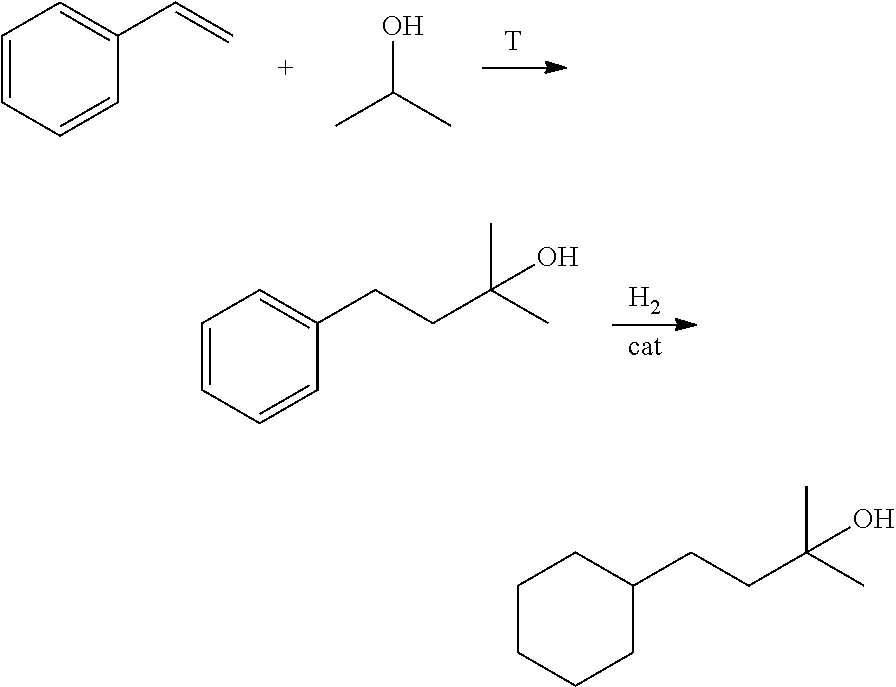Process for preparing 4-cyclohexyl-2-methyl-2-butanol
a technology of hexyl-2-methyl and hexyl-2-butanol, which is applied in the field of process for preparing 4cyclohexyl2methyl2butanol, can solve the problems of not inconsiderable risks, economic unattractiveness, and no further preparation process has been described to date in the literatur
- Summary
- Abstract
- Description
- Claims
- Application Information
AI Technical Summary
Benefits of technology
Problems solved by technology
Method used
Image
Examples
preparation example 1
Preparation of the Hydrogenation Catalyst
[0118]The support material used was a spherical SiO2 support (AF125 type from BASF SE) with a sphere diameter of 3 to 5 mm and a tapped density of 0.49 kg / l. The BET surface area was 337 m2 / g, and the water absorption (WA) 0.83 ml / g. For impregnation, 14.25% by weight ruthenium(III) acetate solution in acetic acid from Umicore was used.
[0119]200 g of support were initially charged in a round-bottom flask. 15 g of ruthenium acetate solution were diluted with distilled water to 150 ml (90% WA). The support material was initially charged in the distillation flask of a rotary evaporator, and the first quarter of the solution was pumped onto the support material at 3 to 6 rpm with a slightly reduced pressure. On completion of the addition, the support was left in the rotary evaporator at 3 to 6 rpm for a further 10 minutes, in order to homogenize the catalyst. This impregnation-homogenization step was repeated three times more until all of the sol...
example 1
[0120]A 400 ml autoclave was initially charged with 2.08 g (20.0 mmol) of styrene and 51.2 g (853 mmol) of isopropanol. The autoclave was closed and the reaction mixture was stirred at 350° C. (autogenous pressure 230 bar). After a reaction time of 2 h in each case, another 2.08 g (20.0 mmol) of styrene were added. After a total of 14 additions, corresponding to a total amount of styrene of 31.2 g (300 mmol), the reaction mixture was allowed to cool, and the autoclave was decompressed. Before each addition, a sample was taken and analyzed by means of gas chromatography for the composition thereof. In this way, the selectivity of the formation of 2-methyl-4-phenyl-2-butanol was determined based on the styrene used. The selectivities are reported in the table which follows:
[0121]
Styrene [mmol]4080120160200240280300Reaction time[h]48121620242830Selectivity [%]90.081.877.370.967.963.959.657.3
[0122]The reaction mixture was worked up by distillation. After removing the low boilers (in par...
example 2
[0124]A 400 ml autoclave was additionally charged with 118 g (1.96 mol) of isopropanol. The autoclave was closed and brought to internal temperature 375° C. (autogenous pressure 244 bar). 2.06 g (19.8 mmol) of styrene were added rapidly thereto and, after 15 min of reaction time, another 2.08 g (20.0 mmol) of styrene were added thereto. Styrene was added in this way four more times. After a total of 6 additions, corresponding to a total amount of styrene of 12.36 g (119 mmol), the reaction mixture was allowed to cool and then the autoclave was decompressed. Before each addition, a sample was taken and analyzed by means of gas chromatography for the composition thereof. In this way, the selectivity of the formation of 2-methyl-4-phenyl-2-butanol based on the styrene used was determined. The selectivities are reported in the following table:
[0125]
Styrene [mmol]19.838.659.479.299118.8Reaction time [min]153045607590Selectivity [%]72.162.565.565.165.263.6
PUM
| Property | Measurement | Unit |
|---|---|---|
| pressure | aaaaa | aaaaa |
| temperature | aaaaa | aaaaa |
| penetration depth | aaaaa | aaaaa |
Abstract
Description
Claims
Application Information
 Login to View More
Login to View More - R&D
- Intellectual Property
- Life Sciences
- Materials
- Tech Scout
- Unparalleled Data Quality
- Higher Quality Content
- 60% Fewer Hallucinations
Browse by: Latest US Patents, China's latest patents, Technical Efficacy Thesaurus, Application Domain, Technology Topic, Popular Technical Reports.
© 2025 PatSnap. All rights reserved.Legal|Privacy policy|Modern Slavery Act Transparency Statement|Sitemap|About US| Contact US: help@patsnap.com

